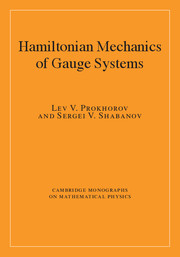1 - Hamiltonian formalism
Published online by Cambridge University Press: 07 October 2011
Summary
Hamilton's principle of stationary action
A dynamical system with a finite number n degrees of freedom can be described by real functions of time qi (t) (i = 1, 2, …, n) which, together with the derivatives qi(t), uniquely determine its state at any moment of time t. The collection of all values of qi is called the configuration space M of the system. In the simplest case, M is a Euclidean space Rn. It can generally be an n-dimensional (differentiable) manifold. In a small neighborhood of each point, a manifold looks topologically like a Euclidean space Rn. This allows one to introduce local coordinates on the manifold M and develop calculus on M. Every point of M has a neighborhood U that is homeomorphic to Rn (there is a continuous and invertible map between points of U and some subset of Rn). Let qi, i = 1, 2, …, n, be rectangular coordinates in Rn. A neighborhood U with local coordinates in it (i.e. with the map ϕ: U → Rn) is called a chart. A manifold can be covered by a set of charts with transition maps between local coordinate systems in the overlap of any two charts. Thus, in a local coordinate system on M, the time evolution of a dynamical system is again described by n real functions qi(t), i = 1, 2, …, n.
Consider trajectories of the system qi = qi(t) on M through a point.
- Type
- Chapter
- Information
- Hamiltonian Mechanics of Gauge Systems , pp. 1 - 67Publisher: Cambridge University PressPrint publication year: 2011



